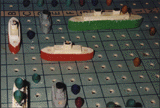|
The Broschwitz Group made paintings for two years on the themes Ship/ Shipswreck/ Baltic Sea and put together about 150 paintings.
Dumping / Ships: The theme is great and heavy. From the beginning we were interested in the tradition of the game and its clear reference to the (martial) history of the German Fleet. The little game is still popular; now there exist video game and internet versions of this game. While starting the first works and searching material, we soon realized the importance of two things. First the force of the facts. Second the threatening quick categorizing of the artistic works on the both general themes, environment and war. The double meaning of the chosen title (in German, the expression "Dumping Ships" is the common name of the game "Battleship") gives a first hint on the artistic plan the Broschwitz Group chose. The artists get closer to the matter in a blurred way: here artistically "playing", there rationalizing, choosing positions in a subjective-historic proximity or out of a cool distance.
Karin Christiansen uses for her paintings post-war photographs of the Marine Port in Kiel, Germany. Inge X Husemann works in a playing and symbolic way with primary elements, fire and water, attacking ships as well as canvases. Sabine Drasen is painting enlargements of old black and white photographs and postcards showing the seaside life at the Baltic Sea. Natalie Friedinger works with nautic maps and aerial views which show shipwrecks lying on the ground of the Baltic Sea. Roland Kreuzer puts typefaces into his abstract paintings and uses texts of found pieces of chemical weaponson the beaches of the Baltic Sea.
The Broschwitz work uses the principle of Fragmenting / Lining up: At the first step there is an individual working with single paintings on the chosen common theme; at the second step a hanging of the single standard-sized paintings in a close block composition. The Broschwitz Group is using this working principle since several years (The "Broschwitz-Muster", "Broschwitz-Pattern", 1998, 1999) und understands this as an essential part of the artistic work.
The Broschwitz Group doesn't work on the theme in any didactic or historic way. The five painters understand themselves as artists, not als scientists.
Parallel to the painting work, Broschwitz realized a wide
Exhibition Tour. Each of these exhibitions was new concepted and contained new work. According to the special emphasis of each exhibition the great painting walls were complemented by an accompanying programme.
June 2000 at
Schloss Bröllin
, August 2000 up to May 2001 at the
Dielenhaus Stralsund, in the
Galerie Am Alten Markt Rostock, and in St. Spiritus Greifswald. June 2001 working and exhibition in the turbine hall of the former power station Peenemünde, part of the
Museum Peenemünde,
September 2001 up to May 2002 in the
Umweltbundesamt Berlin (Federal Environmental Agency of Germany) in
Bornholms Kunstmuseum (Danmark) and
in the former Pomeranian Princes Castle in Szcecin (Stettin), Poland.
In 2001 the catalogue "BROSCHWITZ Schiffe versenken" was published, which contains a selection of 80 paintings and various contributions to the theme. Authors: f.e. Eva Schepermann, Dirk Zache, Frank Politz and Peter Ehlers.
Catalogue: 120 pages, 13 x 13 cm, ca 100 pictures, 5 EUR. Please order by
mail.
An important source of our art project are information of the dumps of chemical weapons from World War II in the Baltic Sea, when the allied forces sunk freighters loaded with chemical agents in the Baltic Sea to get rid of them.
According to Greenpeace it seems to be up to 15,000 tons of chemical weapons as mustard gas und phosphorus. The report of Helsinki Commission from 1995 (final report 95) says that in the recent years barrels and clumps which seemed to contain mustard gas were found in fishing nets. The Federal Environmental Agency of Germany (Umweltbundesamt Berlin) reports found pieces f. e. on the beaches of the island Bornholm. It seems that dumped wrecks, bombs or barrels are rusting through and might gradually set free their contents. Amounts and quantities of dumped chemical weapons and more information of the events in post-war era can be read at Stockholm International Peace Research Institute
(SIPRI)
and at
Mitretek.
to top of page
|

























